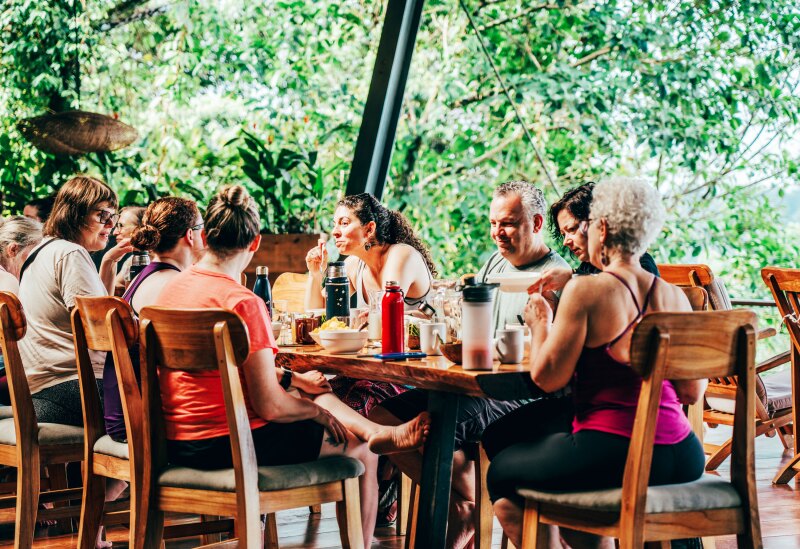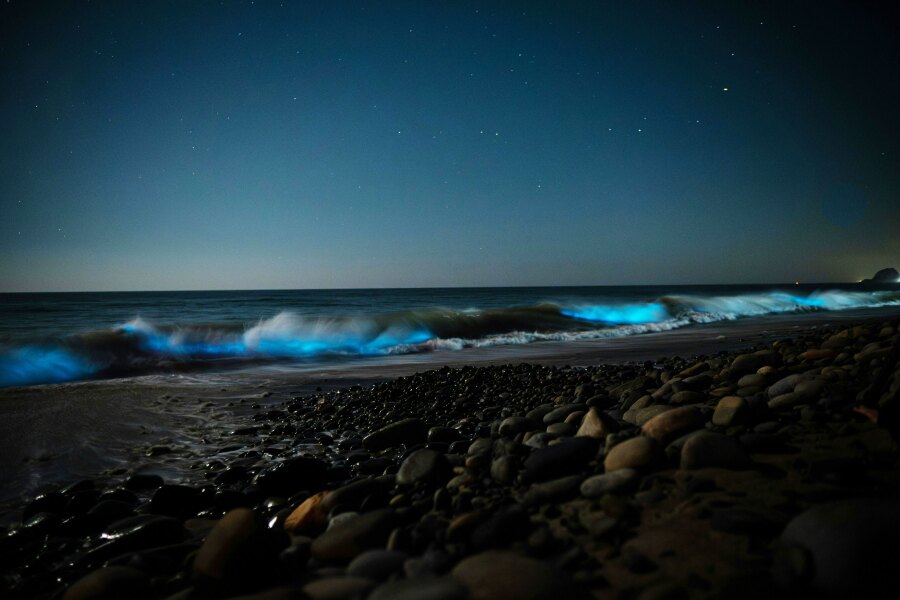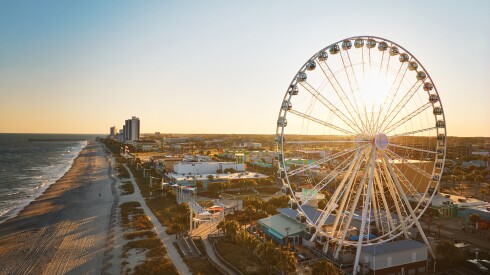I’m floating on my back in the dark. I feel weightless, and there are stars above and below me. I’m not on drugs.
Ten minutes ago, a man with whom I don’t share a language assured me (I think) that there are no stinging jellyfish in the cove he’d driven us into on his small metal speedboat. I was skeptical, because earlier today, I’d been kayaking around some other part of this bay that was full of them.
Regardless, come nighttime, I’d taken the leap. Or rather, the slow, clinging descent down the dinghy’s slippery three-step ladder into what might as well have been a black hole, the water was so opaque. But then my feet rippled the surface, and the darkness exploded with glitter—a quiet big bang around my ankles in the previously dark universe of Panama’s Bahía Almirante.

The treehouses at La Loma Lodge are completely open-air, providing views through the jungle to the Bocas del Toro archipelago.
Photo by Niels Keekstra
I’m staying with two friends at La Loma Jungle Lodge and Chocolate Farm, a collection of open-air tree houses perched among 55 acres of rainforest on Isla Bastimentos, one of the larger islands in the Bocas del Toro archipelago on Panama’s eastern side. The experience is fantastic, and in some ways implausible, as in: I cannot believe how delicious fresh chocolate desserts made from the hotel’s farm taste, and I cannot believe that I just saw a sloth hanging out on a tree on the path to my bungalow, and also I cannot believe how many bugs have bitten me despite the armor of DEET I’m wearing. Note to self: Wall-less accommodations really do immerse you in nature, but also they really do immerse you in nature.
One of the joys I’m finding during my time at La Loma is unexpectedly human-centric: communal dinners. These festive farm-to-table meals are conjured using vegetables, tropical fruits, and chocolate grown in the farm below the tree houses and served to guests from all over the world who gather together around big wooden tables. You’re always welcome to sit separately with your own party for a more intimate meal, of course, and the staff will ask your preference when you check in, but even the honeymooners we saw sitting alone their first night had joined our big convivial table by the second.

La Loma Jungle Lodge and Chocolate Farm occupies 55 acres of the Isla Bastimentos rainforest in Panama. It’s only accessible by boat.
Courtesy of La Loma Lodge
At dinner on the day before my communion with the universe, the chatter among our group (representing Canada, Brazil, the UK, three different time zones of the U.S., and Germany) had turned to the afternoon and full-day excursions that La Loma offers. My two friends and I had taken the day trip to nearby Red Frog Beach for cocktails and sunbathing; most of us around the table had indulged in the tasting tour through the La Loma farm (if you’re wondering what fresh-off-the-tree cacao fruit taste like, this is your chance). There are also hiking and snorkeling trips at Polo Beach around the other side of the island, and kayak adventures through the area’s mangrove alleys and cave systems. But the one that our British tablemate Don could not stop raving about was night swimming in a bioluminescent pocket of water not far from our hotel. It was already on my list and I really wanted to do it, but I admit I was scared and wasn’t entirely sure I’d get out of the boat. I’m a fine swimmer and former (pool) lifeguard, but I’d also grown up in the era of Jaws and had never quite shaken my fear of murky waters and the monsters (both microscopic and massive) that could get me.
But Don had no such apprehensions. He was awestruck. “It’s like holding the night sky in your hand,” he gushed. We giggled at his unselfconscious corniness, but his childlike amazement was contagious. The thing that made it all the more special, he assured us, was that it was difficult to get good photos of the illumination, and there was no real safe place to keep your phone from getting wet. So the experience could only be truly appreciated in the moment. I was rapt. And I felt doubly inspired to follow his recommendation.
That’s how I worked up my courage the next night. Coated in bug spray, I huffed down the hundred-plus stairs from La Loma’s mountainside tree houses to the dock in excited silence with the rest of the gang. Once the boat took off, the night breeze was rejuvenating—almost enough to calm my rising anxiety about swimming in strange water. About 20 minutes later, the driver maneuvered us into a mangrove-edged cove, turned off the engine, and gestured for us to get out.
Trying not to think of how I’d swept my oar in the water and watched dozens of jellies swarm that afternoon, I leaned back off the boat’s ladder and swept my arms through the water. With each gentle movement, I ignited neon blue clouds of bioluminescent algae, harmless single-celled organisms called dinoflagellates.
There were nine of us out that night, but we were nearly silent. Galaxies swirled around us. I stared, mesmerized at my arms, my hands, my fingers, as they lit up the water. I looked around at my friends, new and old, and saw each of them surrounded by the opposite of a shadow. I wanted to swim all night. I wanted to find other bioluminescent swimming holes around the world and float in them, too (you can kayak in Puerto Rico’s Mosquito Bay and take walking tours through New Zealand’s Waitomo Glowworm Caves). Granted, my fear of the dark—and of dark water—never really left me, but the sheer strangeness of science calmed me. For half an hour, we swam, transformed—cupping water in our palms and laughing as we gave Don his due credit. He was right. It was like holding the night sky in your hands.
Make it happen

La Loma Lodge offers a Cacao and Permaculture Tour of the jungle farm. Many of the ingredients for evening meals are grown on-site.
Courtesy of La Loma Lodge
How to get there: Bocas Town is the main hub of Bocas del Toro archipelago, and you can get there easily via daily, 45-minute flights from Panama City. Many cafés, souvenir shops, and restaurants fill this surfer-vibe town. Be sure to walk all the way through any restaurant you enter; most have open-air deck seating on or overlooking the water, which you may not notice from the street entrance (like the Hotel Bocas del Toro’s bar and Caribbean joint Restaurant Tom).
Small water taxis leave from several spots in Bocas Town to take tourists to the many hotels and day-trip destinations scattered around the archipelago. Look for shacks around town with posted information. Your hotel can provide info (and usually a water taxi), too.
Where to stay: La Loma Jungle Lodge and Chocolate Farm is a complex of tree houses about 10 minutes by boat from Bocas Town. The well-positioned houses are completely open-air while still feeling very private. You won’t have any walls but you will have mosquito nets around the beds, running water and hot showers, a hammock, and paradise-like views. Bring lots of bug spray and do not miss a tour of the permaculture farm (which provides a good portion of the produce for three daily meals, all included in the price of the stay). Note that from the dock, guests must climb many, many steps up to the hotel complex, though there’s an elevator contraption for luggage.

Nayara Bocas del Toro is a solar-powered, off-grid, adults-only retreat.
Photo by Billie Cohen
After a few nights at La Loma, we embraced the luxury—and enclosed overwater bungalows—at Nayara Bocas del Toro, named one of Afar’s Best New Hotels of 2023. In addition to looking beautiful from the outside, the resort is impressive behind the scenes, too: It is 100 percent rainwater supplied and mostly runs on solar energy. There’s even a beach built on stilts to safeguard the flora and fauna, where you can sip rosé from a chaise or descend the steps to float in the warm protected waters. You can also do that from your bungalow’s private dock if you prefer.
Things to do: Many travelers come to the Bocas del Toro archipelago for surfing, and there are plenty of other water activities, too—you can arrange them via tour operators in Bocas Town or through your hotel. Most hotels offer similar activities around the archipelago, though prices, lengths, and amenities may vary. Options include day trips to Red Frog Beach, kayaking in the bay, boat outings to watch dolphins play at sunset, and night swimming in a bioluminescent cove.











